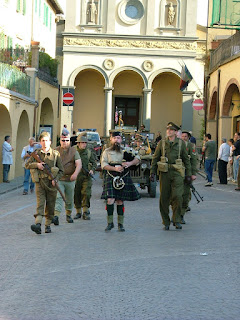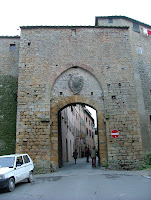 HISTORY: If you
HISTORY: If you had to make the name of the place more than any other sums up the characteristics of the medieval village, the choice probably would fall on Monteriggioni. Its configuration is, in fact, the most significant example of the "land side" of the whole territory of Siena and among the largest in Tuscany.
This village is located 25 kilometers from Siena, along the road that was once known as the Francigena. Until the thirteenth century did not exist as a village, it was just a farm owned by Mr. Hill of Staggia. The Republic of Siena, however, realized the importance of his position and decided to buy it to build a defensive stronghold that was an obstacle to the enemy advanced Fiorentini. It was 1203 and, ten years later, construction began on the raising of the walls, completed in 1219.

front doors the village, still existing, were two: Porta Romea
or free port (left) facing East towards Siena, and
Porta Fiorentina and Porta San Giovanni on the other side, towards Florence. The fortification
allowed to retain possession of Siena Monteriggioni but of course did not stop attempts to attack Florence. The first of these took place in 1244, a decade after the second and third in 1269. But the village always managed to resist, creating a reputation as an impregnable fortress. For about three centuries later, there is no news of further fighting, which resumed in the sixteenth century but with a new attack struck from Florence and successfully rejected. A fate that was repeated in 1526 when attacking was the pontifical army, allied with the Florentines. The town probably never would have fallen out if the defeat had not been a betrayal, that of Captain John
Zeti that April 27, 1554, for personal gain, the fortress surrendered to Florence without even fighting.
Monteriggioni then passed to the Grand Duchy of the Medici, to be sold over the centuries in various families of Siena: from Goliath to Hammer, the Visconti, the Fabbroni, and the Daddi in 1704 to Accarigi, the last descendant of which the family spent the annuity Griccioli (still owns some possessions in the rural district). Today, inside the ancient walls, according to the latest census, 43 people living
. A paradise where time seems to have maintained the slow rhythms of a distant past, surrounded by the colors of the landscape of Siena, that makes for a unique corner of Tuscany.
HIGHLIGHTS: Piazza Roma - The only place in the village, which is reached by both doors. The space has been paved with stones in the sixties from the nearby quarries Rosia, while in the past had not surfaced. Rather broad and evocative, the outside is surrounded by gardens and vegetable gardens (very important in the past to allow the survival of the population in case of siege) and is buildings that overlook the most part have been adjusted to accommodate the tourists.
Porta Romea - rises to the base of a tower on the outside you can see a plaque with the inscription:
"In the year of the Lord 1213, the second call, in March at the time of the Lord of Guelph Ermanno Paganello by Porcari of the Podestà of Siena, Pisa from the Lord Arlotto, wise judge, and Hildebrand of Usimbardi chamberlain of Siena, the castle of Monteriggioni was begun in the name of God and thus completely enclosed by walls and expenses incurred in their work by people of Siena. "  Porta San Giovanni -
Porta San Giovanni - opens the curtain and defended one of the towers of the fortified perimeter. In both ports is sure the presence of
shutters or thick wooden doors covered with iron, which were operated by pulleys and the two inputs in fact still have the marks of the hinges and holes caused the closing of the stakes. The Porta San Giovanni you can also see the signs of
rivellino , another defensive structure of rectangular shape placed in front of the door and also features a drawbridge or a second door.
Pieve di Monteriggioni - the square overlooking the church of Santa Maria Assunta, mixed Romanesque and Gothic style, built in 1219. The church has a

large with single-aisle vaults where you can still see the sign of the old trusses. The nave ends with a square apse vault, where he placed the wooden choir dating from the XVI century. The polychrome façade is built with travertine and sandstone. The portal is surmounted by an arch on top of which are decorated in tile. The bell tower dates from the eighteenth century, erected by Mecacci using old material.
Inside the church you can admire two tabernacles of the fifteenth century, a picture of Madonna by Lippo Vanni, a wooden cross and the church bell donated by the Republic of Siena in 1298.
Way of the walls - E 'can get on some stretch of the road, from which opens a breathtaking view of the surrounding area.
FESTIVITIES AND TRADITIONS: First of July to remember the Medieval Festival
"Monteriggioni's towers crown , now in its fourteenth edition. All information on
http://www.festadimonteriggioni.it/ Then,
October, in honor of Our Lady of the Rosary
, protector of Monteriggioni, the village will welcome guests for a great feast in the square front of the church, the stalls displaying crafts, local pottery and ceramics, while residents offer food and wine the place, including chestnuts.
the evening of Christmas Eve
held a candlelight vigil instead. Participants are distributed torches that illuminate the procession as it moves to the nearby Abbey Abbey Island, where Mass is celebrated. At this torch the castle walls are entirely lit by torches to oil.
LINKS: http://www.comune.monteriggioni.si.it/ http://www.monteriggionicastle.com/

 LINK
LINK 






 Castle for its dominant position on the validity of the Pesa and Elsa, was the scene of important historical events.
Castle for its dominant position on the validity of the Pesa and Elsa, was the scene of important historical events. 


















